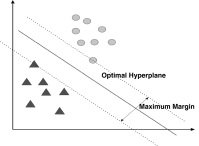False-positive reduction in mammography using multiscale spatial Weber law descriptor and support vector machines
- PMID: 24954976
- PMCID: PMC4055841
- DOI: 10.1007/s00521-013-1450-7
False-positive reduction in mammography using multiscale spatial Weber law descriptor and support vector machines
Abstract
In a CAD system for the detection of masses, segmentation of mammograms yields regions of interest (ROIs), which are not only true masses but also suspicious normal tissues that result in false positives. We introduce a new method for false-positive reduction in this paper. The key idea of our approach is to exploit the textural properties of mammograms and for texture description, to use Weber law descriptor (WLD), which outperforms state-of-the-art best texture descriptors. The basic WLD is a holistic descriptor by its construction because it integrates the local information content into a single histogram, which does not take into account the spatial locality of micropatterns. We extend it into a multiscale spatial WLD (MSWLD) that better characterizes the texture micro structures of masses by incorporating the spatial locality and scale of microstructures. The dimension of the feature space generated by MSWLD becomes high; it is reduced by selecting features based on their significance. Finally, support vector machines are employed to classify ROIs as true masses or normal parenchyma. The proposed approach is evaluated using 1024 ROIs taken from digital database for screening mammography and an accuracy of Az = 0.99 ± 0.003 (area under receiver operating characteristic curve) is obtained. A comparison reveals that the proposed method has significant improvement over the state-of-the-art best methods for false-positive reduction problem.
Keywords: False-positive reduction; Mammograms; Mass detection; Support vector machines; WLD.
Figures










Similar articles
-
A textural approach for mass false positive reduction in mammography.Comput Med Imaging Graph. 2009 Sep;33(6):415-22. doi: 10.1016/j.compmedimag.2009.03.007. Epub 2009 Apr 29. Comput Med Imaging Graph. 2009. PMID: 19406614
-
False-positive reduction in computer-aided mass detection using mammographic texture analysis and classification.Comput Methods Programs Biomed. 2018 Jul;160:75-83. doi: 10.1016/j.cmpb.2018.03.026. Epub 2018 Mar 31. Comput Methods Programs Biomed. 2018. PMID: 29728249
-
False-positive reduction technique for detection of masses on digital mammograms: global and local multiresolution texture analysis.Med Phys. 1997 Jun;24(6):903-14. doi: 10.1118/1.598011. Med Phys. 1997. PMID: 9198026
-
Computer-aided mass detection in mammography: false positive reduction via gray-scale invariant ranklet texture features.Med Phys. 2009 Feb;36(2):311-6. doi: 10.1118/1.3049588. Med Phys. 2009. PMID: 19291970
-
Multi-scale textural feature extraction and particle swarm optimization based model selection for false positive reduction in mammography.Comput Med Imaging Graph. 2015 Dec;46 Pt 2:95-107. doi: 10.1016/j.compmedimag.2015.02.005. Epub 2015 Feb 24. Comput Med Imaging Graph. 2015. PMID: 25795630
Cited by
-
Local Binary Patterns Descriptor Based on Sparse Curvelet Coefficients for False-Positive Reduction in Mammograms.J Healthc Eng. 2018 Sep 25;2018:5940436. doi: 10.1155/2018/5940436. eCollection 2018. J Healthc Eng. 2018. PMID: 30356422 Free PMC article.
References
-
- Mu T, Nandi AK (2005) Detection of breast cancer using v-SVM and RBF networks with self-organization selection of centers. In: Third IEEE international seminar on medical applications of signal processing
-
- American Cancer Society (2003–2004) Breast cancer: facts and figures. ACS
-
- Esteve J, Kricker A, Ferlay J, Parkin D (1993) Facts and figures of cancer in the European Community. In: Technical report on international agency for research on cancer
-
- Pal NR, Bhowmick B, Patel SK, Pal S, Das J. A multi-stage neural network aided system for detection of micro-calcifications in digitized mammograms. Neurocomputing. 2008;71:2625–2634. doi: 10.1016/j.neucom.2007.06.015. - DOI
LinkOut - more resources
Full Text Sources
Other Literature Sources
Miscellaneous
